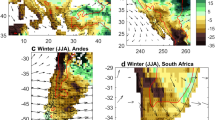Summary
¶Mountains profoundly impact precipitation systems in Taiwan, particularly in areas occupying roughly two-thirds of the island’s landmass. This study examines the terrain structures possibly affecting the formation of rainfall systems in northern Taiwan by analyzing radar data, surface rainfall data, and simulation results from MM5 (Fifth-Generation NCAR/Penn State Mesoscale Model) under a weak synoptic influence condition. More specifically, this study analyzes precipitation systems formed in three different days with different ambient wind directions (i.e., southwesterly, southerly and south-southeasterly flows) in a low Froude number regime in Mei-Yu (or Baiu) season.
The southwesterly (southerly) predominant wind was blocked by CMR (central mountain range) over southwestern (southern) Taiwan. Consequently, the southwesterly (southerly) winds were diverted around southern Taiwan, traveled northward following the terrain contour of CMR and then converged in northeastern (northern) Taiwan to produce a NE-SW (N-S) orientated convergence area. As anabatic flow and onshore flow intensified in northern Taiwan and thus enhanced the existing convergence in the late morning and early afternoon, the precipitation system appeared over slope first and then moved down the slope following the predominant wind direction. Upwards motion persisted in this convergence region, and initiated a new precipitation system. Consequently, rainfall accumulation was orientated in a NE-SW (N-S) direction in northern Taiwan. On the windward side of CMR in central Taiwan, precipitation was first produced in the slope by anabatic flow and was generated in lower land because of the interaction between down slope and onshore flow in the late afternoon. When the flow was predominantly from the south-southeast, the convergence due to the splitting of the predominant over western Taiwan became weaken after onshore flow over west coast developed since the direction of onshore flow was against the splitting predominant flow. Precipitation only appeared in the sloping areas of northwestern and central Taiwan in the relatively dry environment resulting from the anabatic flow.
Several sensitivity tests indicated that the lee-side convergence in a low Froude number regime superimposed by anabatic flow and onshore flow is important for producing rainfall in northern Taiwan. The prevailing wind direction determined the orientation of the rainfall accumulation in northern Taiwan. The high relative humidity is important for precipitation to form in lower elevations.
Similar content being viewed by others
Author information
Authors and Affiliations
Additional information
Received February 9, 2001; Revised November 23, 2001
Rights and permissions
About this article
Cite this article
Lin, CY., Chen, CS. A study of orographic effects on mountain-generated precipitation systems under weak synoptic forcing. Meteorol. Atmos. Phys. 81, 1–25 (2002). https://doi.org/10.1007/s007030200028
Issue Date:
DOI: https://doi.org/10.1007/s007030200028




